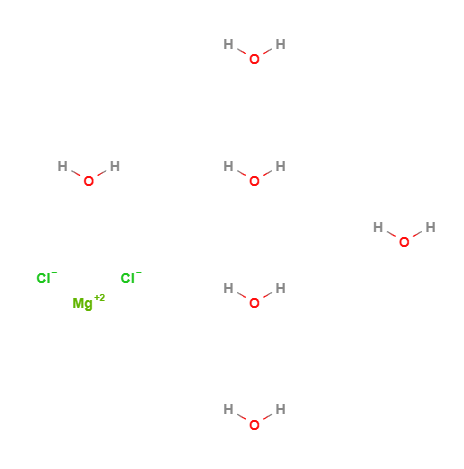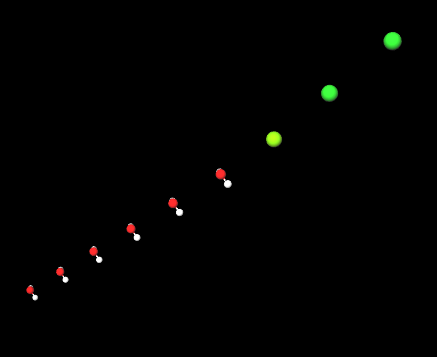![]() Magnesium chloride hexahydrate
Magnesium chloride hexahydrate
Rating : 7
| Evaluation | N. Experts | Evaluation | N. Experts |
|---|---|---|---|
| 1 | 6 | ||
| 2 | 7 | ||
| 3 | 8 | ||
| 4 | 9 | ||
| 5 | 10 |
0 pts from admin
| Sign up to vote this object, vote his reviews and to contribute to Tiiips.Evaluate | Where is this found? |
| "Descrizione" about Magnesium chloride hexahydrate by admin (19545 pt) | 2025-Jan-04 18:42 |
| Read the full Tiiip | (Send your comment) |
Magnesium Chloride Hexahydrate is an inorganic salt consisting of magnesium and chloride ions, with six molecules of water of crystallization. It is widely used in cosmetics, pharmaceuticals, and industrial applications due to its hydrating, stabilizing, and conditioning properties. Known for its ability to improve skin moisture levels and support skin barrier function, it is a key ingredient in skincare formulations aimed at hydration and soothing.
Chemical Composition and Structure
Magnesium Chloride Hexahydrate is represented by the chemical formula MgCl₂·6H₂O.
- Core Components:
- Magnesium ion (Mg²⁺): Plays a vital role in skin hydration and enzyme regulation.
- Chloride ion (Cl⁻): Contributes to the ionic balance and solubility of the compound.
- Six water molecules: Provide the crystalline structure and enhance its hydrating capabilities.
Physicochemical Properties
- Appearance: Colorless to white crystalline solid.
- Odor: Odorless.
- Solubility: Highly soluble in water; moderately soluble in ethanol.
- Stability: Stable under standard conditions; deliquescent, absorbing moisture from the air.
- pH: Slightly acidic in aqueous solutions.
Production Process
Extraction:
- Magnesium chloride is commonly derived from natural sources such as seawater or mineral deposits like carnallite.
Purification:
- The crude material is purified through evaporation and crystallization to achieve the hexahydrate form.
Final Processing:
- The product undergoes drying and quality control to ensure consistency and purity for cosmetic and pharmaceutical use.
Applications
Medical Applications
- Used in topical treatments for muscle relaxation and magnesium supplementation.
- Supports the healing of minor skin irritations due to its hydrating and soothing properties.
In eye drops, it can contribute to:
Electrolyte Balance
- Magnesium is an essential mineral involved in numerous cellular functions, including the health of corneal epithelial cells. Its presence in the eye drop helps maintain an ionic profile similar to the natural fluids of the eye.
Osmolarity Control
- Like other salts (e.g., sodium chloride, potassium chloride), magnesium chloride helps regulate the concentration of solutes in the ophthalmic solution. Proper osmolarity helps prevent irritation and dryness.
Formulation Stability
- Magnesium ions can help stabilize the eye drop solution, keeping other ingredients effective and preserving the solution’s physical and chemical properties over time.
In short, magnesium chloride hexahydrate is used in eye drops to closely mimic the composition of ocular fluids, promoting comfort and overall eye surface health.
Cosmetics
Hydration and Moisturization:
- Included in creams, lotions, and serums for its ability to attract and retain moisture, improving skin hydration.
Soothing and Calming:
- Helps reduce redness and irritation in sensitive skin formulations.
Skin Barrier Support:
- Enhances the skin's natural barrier function, protecting against environmental stressors.
Anti-Aging:
- Assists in maintaining skin elasticity and minimizing the appearance of fine lines by supporting hydration and cellular function.
Industrial Applications
- Used as a stabilizer in formulations to improve the solubility and shelf life of other active ingredients.
- Employed in the production of bath salts and spa products for its therapeutic benefits.
Environmental and Safety Considerations
Biodegradability:
- Magnesium chloride hexahydrate is a naturally occurring mineral and is environmentally friendly when used responsibly.
Safety Profile:
- Considered safe for use in cosmetics and pharmaceuticals.
- Non-irritating and non-sensitizing at typical concentrations; avoid high concentrations that may cause mild irritation.
Sustainability:
- Sourced from abundant natural reserves, with low environmental impact during production.
Conclusion
Magnesium Chloride Hexahydrate is a multifunctional ingredient widely appreciated for its hydrating, soothing, and stabilizing properties. Its ability to enhance skin hydration and barrier function makes it a valuable addition to modern cosmetic and skincare formulations, particularly for sensitive and dry skin.
 |  |
Molecular Formula Cl2Mg.6H2O MgCl₂·6H₂O
Molecular Weight 203.30 g/mol
CAS 7791-18-6
UNII 02F3473H9O
EC Number 616-575-1
DTXSID0020789
CHEMBL3185229
Synonyms:
Magnesium chloride hexahydrate
References__________________________________________________________________________
Zhang C, Jia Y, Jing Y, Wang H, Hong K. Main chemical species and molecular structure of deep eutectic solvent studied by experiments with DFT calculation: a case of choline chloride and magnesium chloride hexahydrate. J Mol Model. 2014 Aug;20(8):2374. doi: 10.1007/s00894-014-2374-6.
Abstract. The infrared spectrum of deep eutectic solvent of choline chloride and magnesium chloride hexahydrate was measured by the FTIR spectroscopy and analyzed with the aid of DFT calculations. The main chemical species and molecular structure in deep eutectic solvent of [MgClm(H2O)6-m]2-m and [ChxCly]x+y complexes were mainly identified and the active ion of magnesium complex during the electrochemical process was obtained. The mechanism of the electrochemical process of deep eutectic solvent of choline chloride and magnesium chloride hexahydrate was well explained by combination theoretical calculations and experimental. Besides, based on our results we proposed a new system for the dehydration study of magnesium chloride hexahydrate.
Usami M, Sakemi K, Tsuda M, Ohno Y. Teratogenicity study of magnesium chloride hexahydrate in rats. Eisei Shikenjo Hokoku. 1996;(114):16-20
Abstract. Teratogenicity of magnesium chloride hexahydrate (MgCl2.6H2O) was examined in rats. Magnesium chloride hexahydrate dissolved in distilled water was given to pregnant Wistar rats by gavage once a day from day 6 through 15 of pregnancy at doses of 0, 200, 400 and 800 mg/kg/day. The pregnant rats were sacrificed on day 20 of pregnancy and their fetuses were examined for malformation. Magnesium chloride hexahydrate caused no increased incidences of fetal malformation, and no toxic signs in the pregnant rats and the fetuses. It was concluded that magnesium chloride hexahydrate has no teratogenicity in rats when given by gavage. The no observed adverse effect level was estimated to be over 800 mg/kg/day for both pregnant rats and rat fetuses.
Nagano, K., Ogawa, K., Mochida, T., Hayashi, K., & Ogoshi, H. (2004). Thermal characteristics of magnesium nitrate hexahydrate and magnesium chloride hexahydrate mixture as a phase change material for effective utilization of urban waste heat. Applied Thermal Engineering, 24(2-3), 221-232.
Abstract. The objective of this study is effective utilization of urban waste heat from emerging co-generation systems, typically available at temperatures of 60–100 °C. The authors investigated latent heat storage by materials with phase change temperatures in the above range, and focused on a mixture of magnesium nitrate hexahydrate as a base material and magnesium chloride hexahydrate as an additive to modulate the melting point. Addition of 5–10 wt% of the latter resulted in a modulated melting point of around 80 °C and a heat of fusion of about 150 kJ/kg. Increasing the mix ratio had little effect on heat of fusion, but allowed the melting point to be reduced to about 60 °C. Repeated melting and solidification tests showed that the heat of fusion and melting point retained their original values after 1000 cycles.
Fezei, R., Hammi, H., & M’nif, A. (2012). Extractive process for preparing high purity magnesium chloride hexahydrate. Chemical Industry and Chemical Engineering Quarterly, 18(1), 83-88.
Abstract. This paper refers a method for the preparation of magnesium chloride hexahydrate (bischofite) from Sebkha el Melah of Zarzis Tunisian natural brine. It is a five-stage process essentially based on crystallization by isothermal evaporation and chemical precipitation. The two first steps were dedicated to the crystallization of sodium chloride and potassiummagnesium double salts, respectively. Then, the resulting liquor was desulfated using calcium chloride solution. After that another isothermal evaporation stage was implemented in order to eliminate potassium ions in the form of carnallite, KCl.MgCl2.6H2O. At the end of this step, the recovered solution primarily composed of magnesium and chloride ions was treated by dioxan in order to precipitate magnesium chloride as MgCl2.6H2O.C4H8O2. This compound dried at constant temperature of 100°C gave good quality magnesium chloride hexahydrate. Besides this salt, the various by-products obtained from the different treatment stages are also useful.
Wang, M. J., Li, M., Bai, L. M., Wang, Q., & Ma, Y. X. (2024). Research on the influence of thermal decomposition of magnesium chloride hexahydrate on the preparation of magnesium oxide and hydrated magnesium hydroxide. Physicochemical Problems of Mineral Processing, 60(5).
Abstract. Magnesium chloride hexahydrate is an important intermediate product in magnesite processing. In order to promote the efficient utilization of magnesite resources, based on the pyrolysis interval of magnesium chloride hexahydrate, the relationship between magnesium oxide with different physicochemical properties and the apparent properties of hydrated magnesium hydroxide was studied. The results show that the effect of temperature on magnesium oxide sintering is stronger than that of holding time. With the increase of calcination temperature and the extension of holding time of magnesium chloride hexahydrate, the calcined product magnesium oxide was sintered into large particle size with the characteristic particle size D50 of 33.89 μm. The crystal was distorted, the chemical activity deteriorated, and the color development time was up to 407 s. When hexahydrate magnesium chloride was calcined at 480 °C with 2 h, it decomposed almost completely. The product, magnesium oxide, consisted of uniformly distributed small coral rod-like particles with strong chemical reactivity and a color development time of 115 s. The particles were small and evenly distributed, with a characteristic particle size D50 of 1.36 μm, and the highest specific surface area reached 7.292 m2/g. The hydrated magnesium hydroxide particles had well-defined edges and corners, with a characteristic particle size D50 of 1.59 μm and a uniform particle size distribution.
Gianturco, S. L., Pavlech, L. L., Storm, K. D., Yoon, S., Yuen, M. V., & Mattingly, A. N. (2020). Magnesium chloride hexahydrate: Summary Report.
Abstract. The University of Maryland Center of Excellence in Regulatory Science and Innovation (M-CERSI), in collaboration with the Food and Drug Administration (FDA), conducted research and outreach to solicit input from the public, including medical specialists, to better understand the use of certain bulk drug substances nominated for use in compounding by outsourcing facilities under section 503B of the Federal Food, Drug, and Cosmetic Act (the Act). In particular, we were interested in how drugs compounded with these bulk drug substances were used historically, and how they are currently used in clinical practice. The research will assist the FDA in its development of a list of bulk drug substances that outsourcing facilities can use in compounding under section 503B of the Act. Research for each bulk drug substance included a systematic literature review, interviews with medical experts and a survey of healthcare practitioners. Our findings for the nominated substance, magnesium chloride hexahydrate, were summarized in this report.
| Sign up to vote this object, vote his reviews and to contribute to Tiiips.EvaluateClose | (0 comments) |
Read other Tiiips about this object in __Italiano (1)
Component type: Chemical Main substances:
Last update: 2025-01-04 15:52:06 | Chemical Risk: |
